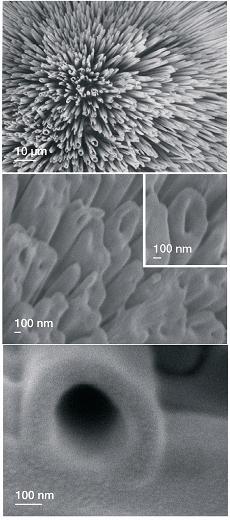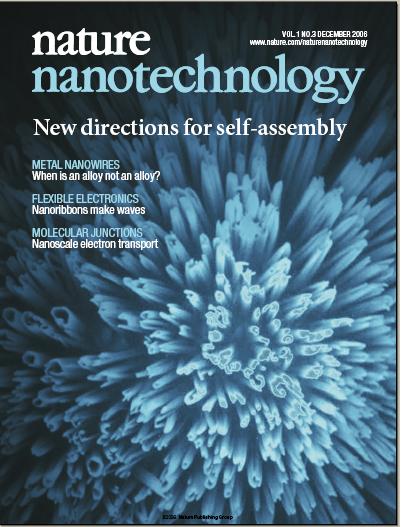A new study by Prof. Ehud Gazit and research student Mital Rakes reveals for the first time a method in the field of nanotechnology that allows the creation of dense arrays of nanometric structures that could be used to produce particularly sensitive detectors for applications of security against terrorism, a method that would allow applications in which to detect explosives, biological or chemical substances on Tiny detector

New research in the field of nanotechnology reveals a new and unique method of self-organization of nanoscale materials that will allow the creation of particularly sensitive detectors, for applications of environmental monitoring and security against terrorism. The new method that was revealed is another evidence of the general revolution that is growing today in the use of nanotechnology for the purpose of obtaining extremely high sensitivity and specificity, in different and diverse fields from medical, chemical, and biotechnological applications to applications in the field of electronics, telecommunications, and security.
Prof. Ehud Gazit and research student Mital Raks from the George S. Faculty of Life Sciences. Wise at Tel Aviv University are the researchers who first revealed the new method in an article published last week, as the cover story in the prestigious journal Nature Nanotechnology. (See the Israel Defense Forces)
The researchers found a way to arrange a nanometer forest of tubes made of peptide material from biological material through self-organization processes and showed the ability of these tubes, whose diameter is about one-thousandth of the diameter of a human hair, to create a small forest that can contain millions of such tubes in an area smaller than the head of a pin. The researchers were also able to arrange the tubes not only vertically into a "nanoforest" but also horizontally by modifying them with tiny nanometer magnets and applying an external magnetic field that caused the tubes to line up in their direction.

In the past, the groups of Prof. Ehud Gazit and Prof. Yehudit Rashpon from Tel Aviv University were able to demonstrate the ability of peptide nanotubes to significantly improve the sensitivity of electrochemical biological sensors. "The biological compatibility, rigidity, and stability of the tubes allows them to be integrated into various electronic, optical, and electromechanical devices. The new method we discovered, for arranging the pipes, is expected to be further improved with many different types of sensors to obtain maximum sensitivity. The arrangement of millions of "hairs" capable of detecting an explosive or a biological or chemical poison on a tiny detector is expected to lead to very innovative achievements in this field." Prof. Ehud Gazit said. In the laboratory, the ability of the peptide structures to be used as contrast agents for MRI, slow release of drugs, and tissue engineering is also tested." Other areas that seem more like "science fiction" at this stage are the use of nanotubes as nanosyringes for intracellular manipulation," Gazit added.
The new method is actually a response to one of the biggest challenges in nanotechnology, the challenge of the spatial arrangement of tiny nanometric structures for the purpose of creating functional devices that will manifest the very unique properties of tiny materials. An especially difficult challenge from an engineering point of view that limits the ability to manipulate such tiny materials. Through biology we learn about the miraculous properties of simple substances to spontaneously organize themselves into complex structures with special activities. Studying the laws of biological self-organization and construction can greatly contribute to the development of nanotechnology in the 21st century.
According to the latest research by Prof. Gazit and his students, it was found that the tubes built from peptide material from biological material through self-organization processes, are not only thin and orderly, but also have unusual chemical and physical properties.
The innovative structures developed by the group in Tel Aviv are based on special interactions called aromatic interactions and they give innovative materials high strength properties at a light weight. An example of this is the special Kevlar fibers used as the strongest plastic fibers, as five steel of the same weight. These fibers are used for various applications from reinforcing tires and plastic frames to being incorporated into body protectors. The group of researchers from TA was able to create a molecular architecture similar to the special polymer, but not in fibers of meters or centimeters but in nanometer tubes. The enormous strength of the pipes developed at Tel Aviv University was determined in the recent past in collaboration with groups from the Weizmann Institute and Ben-Gurion University.
These nanometer tubes were also found to be resistant to thermophoresis and extreme conditions, which will allow their integration into microelectronics production processes. Furthermore, the biological origin of these substances also allows their use in a biological environment, which will enable medical and biotechnological applications that require direct interaction with living systems.
..
Prof. Ehud Gazit is an international scientist, a member of the Department of Molecular Microbiology and Biotechnology at Tel Aviv University and has a visiting appointment at the Massachusetts Institute of Technology (MIT). He is a member of the board of the Center for Nanoscience and Nanotechnology at Tel Aviv University, leads a strategic research program in the field of nanotechnology as part of the European Community Network of Excellence, and is a member of several journal systems in the field of nanoscience, nanotechnology, and biochemistry.
His research, which received global publicity in the scientific community and in the world's leading journals, (examples of NYT) deal with the self-assembly processes in biological, chemical and biochemical systems. Prof. Gazit discovered the minimal elements that lead to the creation of nanometric amyloid fibers in diseases such as Alzheimer's and diabetes and these discoveries are now used for drug development. The characterization of the molecular recognition leading to the construction of the nanometer fibers led to the development of building blocks for nanotubes, nanospheres, and gels with nanometer order. These structures could be used, among other things, for the purpose of building particularly sensitive sensors, contrast materials for nuclear magnetic imaging (MRI) and drug delivery.

The cover of the journal dedicated to the research of Gazit and Rakes

One response
You know that there won't be many comments in this format!!
And if that was your intention, then you succeeded!!..on the other hand, it might take time for them to get used to it...at least I miss the old format!!
In any case, good luck and it's a great site..highly recommended for those interested in science news in Hebrew!!